Theory and Practice of Psychological Counseling
团体辅导中阻抗现象综述
Review on Resistance in Group Counseling
- Authors: 杜长昊 田明冉 马珂悦 王晓刚
-
Information:
西南民族大学教育学与心理学学院,成都
-
Keywords:
Group counseling; Resistance; Review团体辅导; 阻抗; 综述
- Abstract: Group counseling is an effective educational activity for preventing psychological distress and promoting personality development, and since its rise in colleges and universities in the 1980s, it has been widely used in numerous fields such as therapy, education, and vocational training. However, group counseling, as a psychological intervention that provides a real social environment, is bound to produce resistance. This paper summarizes the following forms of impedance in terms of group process and member interaction: silence, pairing and subgrouping, power struggles, irregular attendance and attrition, scapegoating, aggression, rationalization, off-topic discussion, humor, and offering advice and rescue. The group dynamics perspective argues that when group activities progress too close to the underlying conflict, members will exhibit behaviors that withdraw from the discussion, put into action, or otherwise prevent the activity from continuing further; some scholars argue that impedance in group counseling and therapy is essentially the same as impedance in individual counseling and therapy, and refer to Freud's classification of impedance in individual counseling to distinguish and explain resistance in groups; and autopoietic The psychological perspective considers autopoiesis as a part of group autopoiesis. In group therapy, if a conflict event interferes with the group process, members will show impedance because they feel anxious due to the impairment of the group autopoiesis. There are many studies that define and classify impedance in groups, but the theoretical explanation of the causes of impedance in groups is not yet complete, and the relationship between the level of group impedance and the degree of group goal achievement needs to be verified empirically. Therefore, it is necessary to develop a model of impedance in the group counseling process in the future; and to further explore the dynamic patterns of consistency between different work stages and impedance levels in different models. 团体辅导是一种预防心理困扰和促进人格发展的有效的教育活动,自 20世纪 80年代在高校兴起后,已在治疗、教育、职业训练等众多领域得到广泛应用。然而, 团体辅导作为一种能够提供逼真社交环境的心理干预手段,产生阻抗是必然的。 来访者预感自我受到威胁时会表现出阻抗行为,阻抗预示着领导者触及到问题的核心或者症结所在,本文从团体进程和成员互动的层面总结了以下几种阻抗表现形式:沉默、对配与亚团体、权利争夺、成员不规律出席与流失、替罪羊、攻击、合理化、讨论偏题、幽默、提供建议与拯救。团体动力的观点认为,当团体活动进展到过于接近基本冲突时,成员会表现出退出讨论、付诸行动或其他阻止活动继续深入的行为;也有学者认为团体辅导与治疗中的阻抗与个人咨询与治疗中的阻抗在本质上是相同的,并参考弗洛伊德对个体咨询中阻抗的分类来区分和解释团体中的抵抗;而自体心理学的观点则认为自体是团体自体的一部分。在团体治疗中,如果有冲突事件干扰团体进程,成员会因团体自体受损而感到焦虑而表现出阻抗。目前已有较多研究对团体中的阻抗进行界定与分类,但关于团体中的阻抗成因的理论解释尚不完备,团体阻抗水平与团体目标达成程度的关系有待实证验证。因此未来有必要形成针对团体辅导进程中阻抗模型;并进一步探究不同模型中的不同工作阶段与阻抗水平一致性变化的动态模式。
- DOI: https://doi.org/10.35534/tppc.0503013
- Cite: 杜长昊,田明冉,马珂悦.团体辅导中阻抗现象综述[J].心理咨询理论与实践,2023,5(3):123-138.
1 引言
近年,研究者们愈发关注团体咨询与辅导的作用机制,樊富珉等人指出团体凝聚力[1]、团体领导者[2]是影响团体成败的关键因素。阻抗(resistance)作为影响心理咨询顺利进行的重要因素,一直是心理咨询和治疗领域研究的热点。随着咨询理论的发展,阻抗研究的重心已由当事人转向咨询关系中的相互作用(张庭辉,2017)。团体辅导作为一种多人构建出的真实社交场景,领导者与成员、成员与成员之间的互动网络比个体咨询更为复杂,若领导者无法协助成员探索表达与阻抗有关的情感,则会阻碍团体进程,导致成员缺席或退出[3,4],从而损害团体辅导效果,甚至破坏团体[5,6]。但阻抗产生也表明领导者触及问题的核心或者症结所在。面对成员的阻抗行为,领导者应识别其背后隐藏的含义,做出符合成员需求的回应,消除阻抗表现对群体的不良影响,并在此基础上将其转化为促进成员成长的契机。因此,本文首先将阐述各流派关于阻抗的观点,并在此基础上归纳出团体辅导中阻抗的定义,其次重点梳理对当前团体中阻抗表现形式与意义的研究,最后对阻抗产生的原因进行理论解释,并对未来研究进行展望。
2 各流派对阻抗的观念
自弗洛伊德提出阻抗概念以来,阻抗一直是精神分析治疗中的重要概念,咨询工作者们也发展出诸多应对技巧[7]。弗洛伊德发现在临床工作中,来访者会本能地避开会引发心理冲突的话题和事件,采取各种防御机制阻止咨询师将自己无意识中的内容提升到意识层面,从而避免焦虑与痛苦,因此早期精神分析视阻抗为阻碍治疗进展的问题行为[8]。但咨询师们在临床工作中逐渐意识到,即使来访者运用防御机制来减轻改变带来的痛苦,那些已被遗忘的记忆仍会无意识地左右来访者的行为,被来访者压抑的问题会再现于咨询关系之中,也就是移情。随着治疗深入,咨询师会更接近问题核心,即最令来访者痛苦与焦虑的部分,此时来访者会启动防御机制,采取各种行为替代语言表述。因此,弗洛伊德认为阻抗的出现预示着即将抵达工作区[9],阻抗强度代表了被压抑的驱力带给来访者的焦虑与痛苦的程度。咨询师准确辨识来访者移情中的阻抗,予以诠释、将其意识化,才可能实现修通。因此,精神分析流派认为阻抗是治疗过程中非常重要的部分,治疗取得进展很大程度上得益于对阻抗的识别与诠释。
行为主义认为阻抗源于来访者对其行为矫正的不服从和对原有行为模式的依赖,是实现咨询目标的障碍。行为主义强调个体和环境因素而非动力学的因素[10],并称来访者为“不合作个案”,这种不合作行为会暂时或持续妨碍治疗性改变发生[11]。认知行为学派部分承袭了上述观点,认为咨询师挑战来访者原有认知模式时,阻抗就会产生。因为要产生治疗性的改变,来访者需克服自己内在的怀疑和害怕,以及外在不利于改变发生的因素,例如原有环境、他人,和不完美的咨询师。因此,Newman[12]认为咨询师可以从来访者的阻抗中获得有助于制定咨询目标的宝贵信息。
人本主义流派认为阻抗是一种应对威胁的心理防卫。罗杰斯[13]谈到在咨询的初始阶段,咨询氛围对来访者来说还不够安全,自我表露可能会威胁到来访者的自我概念。罗杰斯将阻抗看作个体对自我暴露及其情绪体验的抵制,是个体对于自我架构与发展的一种防护性需要,以防个体的自我认识与自尊受到威胁。Otani[14]进一步解释罗杰斯的说法,认为当个体的经验与其原有的自我概念不一致或冲动时,该经验会被扭曲或是排除意识之外,使得来访者在咨询中不愿揭露相关的经验。Patterson[15]也认为来访者表现出阻抗是因为不想面对不理想的自我。
从各流派解释阻抗的演变可以看出,无论是一对一的个体咨询还是多人同时进行的团体治疗与辅导,人们不再拘泥于将阻抗视为亟待消灭的破坏因素,而改用发展和建设性的目光看待,即如何利用阻抗促进当事人成长。为了让团体成为每位成员展现其关系缩影的组织,团体应发展成一个运作顺畅,足以让成员产生信任感的组织。成员应有机会表现阻抗,因为克服阻抗才能带来改变[16]。领导者应看到阻抗背后的工作区域,相信团体能够容忍压力。如果领导者能协助成员探索和表达与阻抗有关的情感,让成员体验并了解阻抗的来源,则能在很大程度上化解阻抗带给团体与个人的不良影响,帮助成员改变与成长。
3 团体阻抗的表现形式
针对团体阻抗的研究包括某种具体的不利于团体发展的行为表现的成因和处遇,不同资质领导者带领的团体以及非自愿团体等特殊团体中阻抗表现形式。下面将对近年来文献中的种种阻抗现象进行分类总结。
3.1 团体进程中的阻抗
3.1.1 沉默
沉默通常表现为团体成员在领导者或其他团体成员问答时不予回应。沉默的原因可能有很多,如团体动力不足,成员参与度低,不想回答或者团体进行时专注不足[17-19]。Bry[20]认为成员的沉默多由谈论性、死亡、与父母的关系等特定话题带来的焦虑与恐惧所致,并称之为“选择性沉默”。偶尔的沉默可能不会影响团体,过多的沉默则会带给成员和领导者压力[5],新手领导者更容易对长时间的沉默感到尴尬、紧张甚至懊悔,并导致带领团体的信心下降[21]。尽管在某些情况下,沉默代表的是敌意、困惑、灰心或退缩,但它也能传达团结和合作[22]。当团体完成一次深入探索并宣泄完感情,或是经历“高峰”体验后,成员会通过沉默来放松和恢复[23]。
3.1.2 配对与次团体
Fenchel和Flapan[24]指出,团体辅导整个过程中都有可能出现“配对”(pairing),即团体中某两位成员的关系会比其他成员更为亲密,不同配对的成员与构成动机均有不同,但大多是因为对某特定问题有共同认知,或因寻求同性密友产生的。超过两人的“配对”则被定义为“次团体”(subgroup)。有时次团体是由若干配对组成的。次团体内的成员会因分享共同的问题和看法而获益,如获得认同感、提升自尊水平和自我强度等[25]。配对和次团体常见于团体初期,此时成员的参与程度与表达频率是不同的,几个更为活跃的成员可能会结成次团体,其他相对被动的成员则被排除在外。若不加干预,次团体会垄断组内的时间。Conyne[26]还补充道,团体产生冲突时也会形成次团体,这种紧张的动态关系对团体发展是必要的。将对抗产生的阻力转化为变革过程中不同但平等的力量,有利于帮助小组和领导者免于陷入“我与他者”的二元对立叙述[27]。
3.1.3 权力争夺
权力争夺(power struggles)指成员与成员之间,或成员与领导者之间互相争夺对团体的控制权[5]。未及时处理成员之间的权利斗争易导致“垄断”,即团体时间由某位或某几位成员霸占,成员们无法平等共享时间。对此,领导者需平等地分配每位成员的时间,不偏袒任何一位成员。成员与领导者之间的权力争夺常表现为对领导者方案设置或介入的质疑,认为团体是无效的[17],以及故意忽视或直接对抗领导者[28]。在一个健康的团体中,权力由领导者和成员共享,且团体仍是灵活的。放任成员之间或成员与领导者之间的竞争会破坏团体的凝聚力,导致团体无法继续推进[29]。
3.1.4 成员不规律出席和流失
不规律出席指成员在团体进行过程中,请假或无故缺席等情况超过两次以上[3]。在未正式脱离团体的情况下,无规律地进出团体会破坏团体的凝聚力,其他成员会对缺席成员产生疑问与情绪,同时缺席者也难以对团体产生认同与归属感,以致团体动力难以提高,严重甚至导致成员流失[30]。成员的不规律出席通常与其自身问题严重程度、惯用应对方式[31],以及成员对团体主题的期待有关。但也有观点认为成员的不规律出席是为了引起领导者的注意[32],尤其在团体初期,成员对团体仍抱有怀疑,且难以与其他成员就团体达成共识,这时常会出现只有较少成员出席的情况,领导者必定会留意缺席的成员。
3.2 团体成员之间阻抗
3.2.1 替罪羊
替罪羊是一种极具破坏性的阻抗表现形式,Toker[33]认为替罪羊的功能是承受所有成员的指责与攻击;当团体内成员受到挫折或自身经验被侵犯时,往往会让某位成员来承担其他成员的不安与焦虑。寻找替罪羊的过程会对团体互动产生负面影响,李郁文[34]用防御机制解释替罪羊现象:当成员欲将自身的欲望、诉求与过错投射至其他成员身上时,便会寻找替罪羊;而某位成员一旦认同他人投射的内容,并将其内化为自己的一部分,则会成为替罪羊。若领导者采取“此时此地”的技巧[16],协助投射者与被投射者彼此互动,并充分讨论这段经验,或许可以帮助成员发展出更好的人际互动方式[35]。
3.2.2 攻击
团体中的攻击行为可分为两种,一是针对成员的攻击,具体表现为某位成员总是言辞激烈地攻击团体中其他或所有成员,其言语带有一定的侮辱性,有时也上升至某个较大的群体[4]。这种攻击会激怒甚至伤害其他成员,破坏团体关系,使团体难以继续运作,领导者需立即出手制止。二是针对团体中正在谈论的问题、事件或个人观点的攻击[5],原因可能是团体当下讨论的话题与该成员未曾处理的创伤经历有关,在此之前他缺乏被接纳的经验,所以符合社会标准的团体压力也会引起这类成员的应激和反叛。但Belmont[36]认为适当的攻击行为能够增加团体的丰富性。
3.2.3 合理化
合理化指成员将自己的问题行为解释成应对某种刺激的正常反应,或寻找借口掩盖情感体验,并延伸出其他不合理认知。这意味着成员还不愿就某些主题进行探讨或暂未在认知层面获得领悟[5]。合理化与成员个人特质有关[37],若成员本身缺乏安全感或开放度较低,此时领导者介入可能会增强成员的防御。
3.2.4 讨论偏题
讨论偏题常发生在工作阶段初期,成员采取“顾左右而言其他”的方式来回避自我表露和感情探索,例如闲聊、附和领导者或将话题转移到其他成员甚至领导者身上[25],这在非自愿团体中更为常见[17,38,39]。而在新手领导者带领的团体中,可能更多表现为讨论浮于表面,难以深入。多由领导者经验不足,团体目标不够明确,或缺乏自信而不愿打断成员,不知如何介入导致[21]。
3.2.5 幽默
部分成员会用幽默、戏谑或自嘲的方式进行自我表露,如果表达得当,成员的幽默能够缓和团体中紧张、压抑的氛围。在Ormont[40]提供的案例中,一位成员诙谐的笑话和轻率的话语为其他成员提供了保护,使他们免受伤害。但成员也会在面对暴露出的问题与缺点时采取“一笑置之”的态度,以此回避进一步暴露带来的不安与恐惧,或是通过讽刺表达自己对其他成员和团体的不满,林子轩[17]认为其本质是攻击与否定。这种不合时宜的幽默会妨碍成员进一步表露,打断成员之间的共情进程[41],干扰团体进展。
3.2.6 提供建议
一些对心理学或其他领域有所了解的成员会提供建议协助团体,更多时候则是解读他人的行为和问题,以此获得一定程度的关注[5],林孟平[42]将这类成员称为“导师”。尽管这些建议是有效的,但过快地提出建议会剥夺其他成员深入探索自身的机会,并且他们往往是基于“成员一定会改变自己的行为”的不合理假设来提出解决方案的。此时成员确信自己发现了“真相”,并且有义务将其分享给他人,以便他们也能获得 “真理”,但这会带给其他成员压迫感和不被尊重感[21,37]。在团体早期阶段,领导者鼓励成员表达的同时,也应用更为直接的干预方式限制成员对特殊议题发表长篇大论,因为那些具有高度集中兴趣的成员往往难以察觉和回应成员表达的社会线索[43]。
3.2.7 拯救他人
当感觉到某个成员陷入负面情绪或面临压力情景时,其他成员可能会采取行动缓解他的痛苦,以拯救那位陷入“危机”的成员[44],例如直接安慰以缓和当事人的情绪,或提出新话题来吸引注意;领导者需对这种微妙的帮助保持警惕。但也有成员会采取更具破坏性的拯救行为,比如替当事人回答其他成员的提问,通过对质来阻止其他成员鼓励当事人深入探索感受或问题等[42]。这种“拯救”看似让获助成员远离痛苦,实则剥夺了他获得领悟与成长的机会,团体进程也因此被打断。
4 对团体阻抗产生的理论解释
4.1 基于团体动力观点的理论
Fenicle最早将团体阻抗划分为急性阻抗(acute resistance)和特质阻抗(character resistance)。急性阻抗通常在领导者或组员提出具体建议或解释时产生,即当团体活动进展到过于接近基本冲突时,成员会表现出退出讨论、付诸行动(act out)或其他阻止活动继续深入的行为;特质阻抗则无关于组内具体活动带来的刺激,它是成员原有的常用防御机制在当下情境中的体现[20]。随后,Fenchel和Flapan[24]进一步将团体治疗中的阻抗现象划分为团体中的个体阻抗(individual resistance in group)和团体阻抗(group resistance),其中前者指因成员未处理好的潜意识冲突而产生的有碍于团体治疗的行为,后者则指所有成员表现出的不利于团体治疗的行为。由于所有成员进入团体时都带有各自的人格与经历,并用这样的方式与组内成员交往,因此团体中的个体阻抗也常有不同的表现,其中又以移情阻抗(transference resistance)与特质阻抗(character resistance)最为常见[45]。顾名思义,产生移情阻抗的成员会将对家庭中重要人物的感情投射至领导者或其他成员身上;Ormont[46]甚至认为团体中所有的阻抗都是移情的表现,成员会将自己生活中重要人物的特质归结到其他成员身上,并拒绝与其互动。特质阻抗指成员自发地、无意识地运用某些特定的防御机制与外在世界互动。这些防御机制是成员自我认同的一部分,因此很难在团体辅导中完全消除这种阻抗,但可以通过提升成员自尊水平让防御不那么僵化。而对于团体阻抗,不同学者提出了不同的看法。Kadis[47]用团体反应(G response)来代指团体辅导中出现的种种有碍于辅导活动的行为,即把所有成员表现出的阻抗视为一个整体,目的在于对抗辅导中产生的焦虑以维持平衡。Rosenthal[48]也认为团体中大部分或所有成员都会在同一环境中发展出共通的情感,并以某种相似或相同的方式来对抗领导者;但他并不将团体阻抗视为整体,而将其看作是所有个体阻抗的总和。他指出当团体中某些成员对一个事件持相同看法,或出现配对(pairing)和亚团体(subgroup)时,成员们的个人阻抗就有可能发展成团体阻抗。
4.2 基于动力学观点的理论
Rosenthal认为团体辅导与治疗中的阻抗与个人咨询与治疗中的阻抗在本质上是相同的,他参考弗洛伊德对个体咨询中阻抗的分类来区分和解释团体中的抵抗[49]。在团体初期,常出现抑制阻抗(repression resistance)即自我(ego)防御的阻抗,表现为成员有意识地隐藏一些与自身生活相关的信息,或只谈论某种具有独特个人意义的话题。例如某位成员只在谈及母亲时加入讨论,话题结束后则继续保持沉默。抑制阻抗源于自我早期发展阶段,用于抵御由群体经验和暴露家庭关系所引起的焦虑,其中包含了关于成员早期关系与行为模式的宝贵信息。这时成员可能会坚持做一些违背团体规则的事情,例如沉默或阻止他人发言,或者当领导者希望团体共同行动时态度消极。超我阻抗(superego resistance)是团体中最常见的阻抗形式,通常与羞愧、内疚、自罪等情感有关,可能表现为对不符合道德要求的成员态度严厉,不愿与之合作,持续批评或攻击对方;也可表现为严厉、惩罚性的自我批判,一些成员认为自己不值得从团体中获益。需要注意的是,超我阻抗可能与从事或遭遇过高度污名化的事件有关,领导者应保护成员免遭隐私泄露的伤害。本我阻抗(ID resistance)更多源自成员的无意识倾向,即人格发展阶段欲望满足程度,阻抗表现形式与成员所处的固着阶段一致。例如口唇期阻抗可能会采用婴儿似的被动、依赖的态度,并在行为上表现为一味等待治疗师说话,或不停地帮助、建议和理解却不愿付诸行动。而在二级收益阻抗(secondary gain resistance)中,成员常常从自己的问题以及问题的持续中获得某种满足。它常在团体的最后阶段表现出来,当成员试图维持他们从自己的问题中获得的好处时,他们会尝试延缓、推迟、甚至拒绝解决改善,那些已经解决的问题会在这时重新表现出来,而领导者往往很难察觉。
4.3 基于自体心理学的观点
自体心理学(self psychology)主要描述古老自恋(archaic narcissism)如何发展为健康的自尊,强调个体与早期养育者的关系的重要性。科胡特[50]提出,自体(self)的发展源于一个平和的、能够安抚并支持个体的环境,这种经验有助于自体的内在整合,促进自体成长。科胡特[51]重视来访者的自体,认为保存自体应位于个体内部精神活动之首。在临床实践中,科胡特通过对病人的深度共情,他发现阻抗是来访者保护其自体免于崩溃的有价值的活动,即认识到来访者的阻抗有可能来自对自体的保护。吕伟红[52]认为,治疗师应认识到来访者的阻抗有可能来自对自体的保护,就会在治疗中有更为共情和更少伤害性的应对。尽管科胡特并未将自己的理论运用至团体治疗当中,但他提到自体是团体自体(group self)的一部分[53]。团体自体可以代表理想的家庭、环境、文化,这与自体的倾向是一致的,生于和谐的家庭或强盛的国家都能提高个体的自尊水平。而在团体治疗中,如果有冲突事件干扰团体进程,成员会因团体自体受损而感到焦虑。
根据自我心理学(ego psychology)与客体关系理论,传统的团体发展模型认为团体可分为形成期、风暴期、工作期与结束期四个阶段[54]。在形成期,成员会通过与领导者建立联结来减低焦虑。成员希望领导者是全知全能的,以带给他们安全感。此时成员退化到古老自体客体需求(archaic self object need),领导者已不是一个个体(individual),而是处理成员焦虑的功能体(function)。若领导者与成员所需的理想化形象不符,成员则会去寻找其他理想的自体客体,以此缓解因自体受威胁带来的焦虑。到了风暴期,成员会对其他成员与团体领导者产生移情(transference),此时成员内心充满了限制与无助,他们害怕被拒绝与被责骂某些受过创伤的成员害怕他们的愤怒,具体表现为沉默或其他行为受限。工作期是成员获益最多的阶段,成长较多的成员似乎可以担任领导者的角色,鼓励成员之间分享有意义的诠释或进行带有共情的联结。此时领导者会因混乱产生反移情:即成员与领导者竞争团体领导者的角色,或者表现出退缩行为。而在结束阶段,成员会因丧失感到失落,并对即将消失的团体的自体客体功能依依不舍,某些成员会因难以处理分离情绪提前退出团体。
5 小结
综上所述,阻抗是一种相当普遍的现象,即使在真实社交场景中也会有阻抗产生,团体辅导作为一种能够提供逼真社交环境的心理干预手段,阻抗的产生是必然的。目前已有较多针对不同团体以及影响团体进展因素处遇的研究,研究者们区分定义了多种阻抗表现形式,并从团体动力、精神分析以及自体心理学等方面对阻抗成因进行理论解释。但当前关于团体辅导中阻抗行为的研究仍存在诸多有待开发的内容,未来研究可在如下方向上继续开展。
首先,如前文所述,关于团体中的阻抗成因的理论解释尚不完备,团体阻抗水平与团体目标达成程度的关系有待实证验证。因此未来有必要形成针对团体辅导进程中阻抗模型;并进一步探究,不同模型中的不同工作阶段与阻抗水平一致性变化的动态模式。以自体心理学对阻抗成因的解释为例,未来可以将传统团体发展模型中的不同工作阶段与阻抗表现相结合,通过操纵领导者的介入方式,来进一步区分阻抗水平在不同工作阶段中的变化趋势,并有可能发现不同发展阶段中,阻抗水平与领导者风格、经验水平以及接入方式之间是否具有不同的规律。
其次,无论是经验老到的领导者或新手领导者,都会以个人特质或反移情的方式将未处理好的个人议题带入团体,进而干扰团体进程[55]。目前关于团体阻抗的研究多聚焦于成员,对于领导者的领导风格、经验水平、所持理论观点,以及领导者对成员与团体的投射和反移情,成员与领导者之间的互动方式会对团体阻抗产生何种影响还有待进一步探究。
最后,阻抗现象本身涵盖范围极广,从阻抗生发到结束的过程就包含诸多主题,例如阻抗的成因、行为表现、干预策略、时机以及干预的后果,若考虑到团体的性质与发展阶段,还可延伸出不同团体发展阶段中各个阻抗之间的联系。因此未来可以进一步增加对团体历程研究, 关注团体在不同发展阶段表现出的阻抗现象之间是否存在某种联系。除此之外,还可以对比不同性质团体(如未成年人与成年人团体,同质性与异质性团体,学生团体与社会人员团体等)的阻抗表现是否存在差异,或某类团体是否有其独特的阻抗行为。
参考文献
[1] 贾烜,樊富珉,何瑾.团体辅导凝聚力问卷的编制[J].中国临床心理学杂志,2022,30(1):236-240.
[2] 郭颖,樊富珉,张英俊,等.团体咨询师胜任力量表的编制[J].心理与行为研究,2021,19(6):809-815.
[3] 李盛芬,陈怡君.团体咨商中成员不规律出席行为[J].辅导季刊,2007,43(4):66-71.
[4] Bateman A,Campbell C,Fonagy P.Rupture and repair in mentalization-based group psychotherapy[J].International Journal of Group Psychotherapy,2021,71(2):371-392.
[5] Berg R C,Landreth G L,Fall K A.Group counseling:Concepts and procedures[M].Routledge,2017.
[6] Markus H E,Abernethy A D.Joining with resistance:Addressing reluctance to engage in group therapy training[J].International Journal of Group Psychotherapy,2001,51(2):191-204.
[7] Mahalik J R.Development of the Client Resistance Scale[J].Journal of Counseling Psychology,2014,41(1):58-68.
[8] 曾正奇,林怡君.从个体内观点看来谈者抗拒行为[J].咨商与辅导,2018(324):54-58.
[9] Cowan E W,Presbury J.H.Meeting client resistance and reactance with reverence[J].Journal of Counseling & Development,2000,78(4):411-419.
[10] 侯振虎.心理咨询中的阻抗现象解读[J].思想理论教育,2008(21):73-78.
[11] 林玉珊.以讯息处理观点解释咨商中的抗拒[J].咨商与辅导,2012(319):43-46.
[12] Newman C F.A cognitive perspective on resistance in psychotherapy[J].Journal of clinical psychology,2002,58(2):165-174.
[13] Rogers C R.A process conception of psychotherapy[J].American Psychologist,1958,13(4):142.
[14] Otani.A Client resistance in counseling:Its theoretical rationale and taxonomic classification[J].Journal of Counseling & Development,1989,67(8):458-461.
[15] Patterson C.In Understanding Psychotherapy:Fifty Years of Client-Centered Theory and Practice[M].PCCS Books,2000.
[16] Yalom ID,Leszcz M.The theory and practice of group psychotherapy(6th ed)[M].Basic books,2020.
[17] 林子轩.非自愿性成员在团体中之抗拒行为:一个性侵害加害人刑后强制治疗团体的观察[J].中华团体心理治疗,2017:23(1):29-44.
[18] 汤华盛.团体发展各阶段的自体心理学的观点[J].中华团体心理治疗,2021,27(2):17-22.
[19] DeLucia-Waack J L,Kalodner C R,Riva M.Handbook of group counseling and psychotherapy[M].Sage Publications,2013.
[20] Bry T.Varieties of resistance in group psychotherapy[J].International Journal of Group Psychotherapy,1951,1(2):106-114.
[21] 魏嘉伶,周彥伶.新手领导者带领青少年团体的僵局经验[J].中华团体心理治疗,2019,25(1):4-17.
[22] Kottler J,Englar-Carlson M,Thousand Oaks C S.Learning group leadership:An experiential approach Thousand Oaks[M].Sage Publication,2015.
[23] Jacobs E E,Schimmel C J,Masson R L,et al.Group counseling:Strategies and skills[J].Brooks Cole Pub Co,2011.
[24] Fenchel G H,Flapan D.Resistance in group psychotherapy[J].Group,1985,9(2):35-47.
[25] Corey G.Theory and practice of group counseling[M].Cengage Learning,2015.
[26] Conyne R K.The Oxford handbook of group counseling[M].Oxford University Press,2010.
[27] Bemak F,Chung R C Y.Race dialogues in group psychotherapy:Key issues in training and practice[J].International Journal of Group Psychotherapy,2019,69(2):172-191.
[28] 林淑君,王丽斐,谢珮玲.团体带领者僵局经验之初探性研究[J].教育心理学报,2012,43(4):899-919.
[29] Eubanks C F,Warren J T, Muran J C.Identifying ruptures and repairs in alliance-focused training group supervision[J].International Journal of Group Psychotherapy,2021,71(2):275-309.
[30] 柯雅华.实习咨询师对团体成员流失现象的知觉,因应方式及其內在经验之分析研究[D].台中:亚洲大学,2011.
[31] Christensen K R,Valbak K,Weeke A.Premature termination in analytic group therapy:Dropout frequencies and pretherapy predictors[J].Nordisk Psykiatrisk Tidsskrift,2018,45(5):377-382.
[32] Robak R W,Doshi P V,Tursi M M.Exploring Key Group Counseling Processes:Implications for Group Counselor Training[J].Journal of Counselor Preparation and Supervision,2022,15(2):8-39.
[33] Toker E.The scapegoat as an essential group phenomenon[J].International Journal of Group Psychotherapy,1972,22(3):320-332.
[34] 李郁文.团体动力过程中代罪羔羊现象的探讨[J].咨商与辅导,1997(143):40-42.
[35] 陈幼玲.团体治疗的催化与转:化以表达性艺术治疗与华人家族排列小和解为例[D].衡阳:南华大学,2018.
[36] Belmont J.150 More Group Therapy Activities & TIPS[M].PESI Publishing & Media,2016.
[37] 颜嘉萱,李瑜庭,王歆韶,等.不同依附风格成员于团体历程中的人际互动之探究与启发[J].辅导季刊,2020,56(2):17-26.
[38] 陈宏茂.非自愿性团体的经验与团体动力:以酒驾道安讲习班为例[J].中华团体心理治疗,2021,27(3):23-31.
[39] 陈逸群,蔡宛蓁,钟明勋.药瘾团体心理治疗的面质—团体个案报告[J].中华团体心理治疗,2021,27(4):2-10.
[40] Ormont L R.Group resistance and the therapeutic contract[J].International Journal of Group Psychotherapy,1968,18(2):147-154.
[41] 邵瑾,樊富珉.团体成员共情的影响因素及作用模型:基于扎根理论[J].心理科学,2021,44(4):997-1003.
[42] 林孟平.团体咨询与心理治疗[M].北京:生活书店出版有限公司,2021.
[43] Gullo S,Kivlighan D M,Giordano C,et al.Bond and work ruptures in group counseling[J].Group Dynamics:Theory,Research,and Practice,2021,25(1):29-44.
[44] David Kinzie J,Leung P,Bui A,et al.Group therapy with Southeast Asian refugees[J].Community Mental Health Journal,1988,24(2):157-166.
[45] Flapan D,Fenchel G H.The developing ego and the emerging self in group therapy[M].Jason Aronson,1987.
[46] Ormont L R.Resolving resistances to immediacy in the group setting[J].International Journal of Group Psychotherapy,1993,43(4):399-418.
[47] Kadis A L.Re-experiencing the family constellation in group psychotherapy[J].Journal of Individual Psychology,1956,12(1):63.
[48] Rosenthal L.Resolving resistance in group psychotherapy[M].Jason Aronson,1993.
[49] Rosenthal L.Resistance in group therapy:The interrelationship of individual and group resistance[J].Modern Psychoanalysis,2005,30(2):7-25.
[50] Kohut H.The search for the self:Selected writings of Heinz Kohut 1978-1981[M].Routledge,2018.
[51] 科胡特.精神分析治愈之道[M].重庆:重庆大学出版社,2011.
[52] 吕伟红.科胡特自体心理学理论对心理治疗的启示与助益[J].学术交流,2014(10):49-53.
[53] Kohut H.Creativeness,charisma,group psychology:Reflections on the self-analysis of Freud[J].Psyche,1976,29(8):681-720.
[54] Tuckman B W.Developmental sequence in small groups[J].Psychological bulletin,1965,63(6):384-399.
[55] 洪雅凤.团体治疗中的抗拒与反抗拒[J].辅导季刊,2004,40(1):12-25.
















